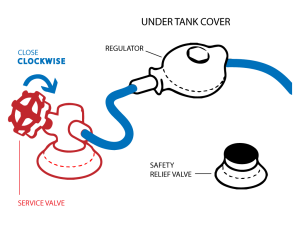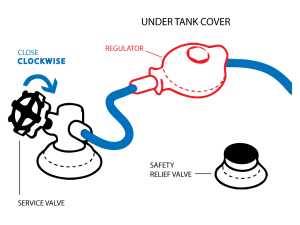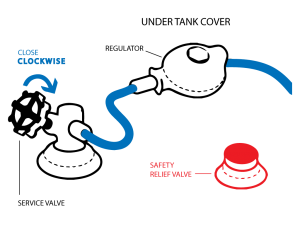We can never be too prepared for natural disasters. Also, when living in a rural area and relying on propane as your cleaner energy source it is important to know how and where to turn you tank off. Your propane tank has safety features to protect you and your family in the case of fire, earthquakes, floods, or other natural disasters.
Three key components of your tank are found underneath the protective “tank cover” on top of the tank. Knowing what these components are essential is to maintaining safe use of your propane tank. Read below for information about these safety features of your propane tank:
The Service Valve
The service or “shut-off” valve is the metal spigot-like dial seen under the tank cover and plumbed to the top of the tank. You should use this valve to turn the gas off at the tank during an emergency or leak. Always turn this valve clockwise, to the right, fully to shut off gas.

The Regulator
The regulator is a flat, circular piece connected by a tube to the shut-off valve. This piece of equipment controls the flow and pressure of propane being delivered from the tank to your home’s appliances.

The Safety Relief Valve
The round, capped safety relief valve is located near the shut-off valve on the base of the tank. This protects the tank in the case of high-pressure situations caused by emergency events such as a fire. The valve may open on its own if the pressure inside the tank gets too high and will close again when the pressure returns to normal. Be sure to always keep your face and hands clear of this valve.

It is important to always keep your eyes, ears and nose out for warning signs of any problems with your propane tank. “Rotten-egg” odors and whistling sounds that signify a leak are such signs. Be sure to take immediate action and call Delta Liquid Energy if there are signs of danger.
What to Do in Bad Weather:
Flood: Turn off the gas valve at the cylinder or tank before water rises.
Snow: Clear heavy snow and ice from regulators, regulator vents, piping, tubing, and valves. Also, keep clear your appliance vents, chimneys, and flues.
Storm: Turn off the main gas supply valve if tank shifts position or if gas lines are bent, broken or damaged. Only do this if it is safe to do so.